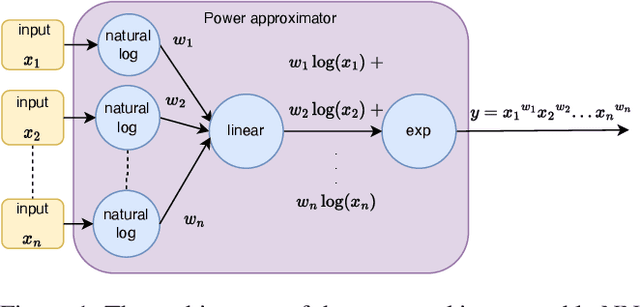Nisal Ranasinghe
Graph-Eq: Discovering Mathematical Equations using Graph Generative Models
Mar 30, 2025Abstract:The ability to discover meaningful, accurate, and concise mathematical equations that describe datasets is valuable across various domains. Equations offer explicit relationships between variables, enabling deeper insights into underlying data patterns. Most existing equation discovery methods rely on genetic programming, which iteratively searches the equation space but is often slow and prone to overfitting. By representing equations as directed acyclic graphs, we leverage the use of graph neural networks to learn the underlying semantics of equations, and generate new, previously unseen equations. Although graph generative models have been shown to be successful in discovering new types of graphs in many fields, there application in discovering equations remains largely unexplored. In this work, we propose Graph-EQ, a deep graph generative model designed for efficient equation discovery. Graph-EQ uses a conditional variational autoencoder (CVAE) to learn a rich latent representation of the equation space by training it on a large corpus of equations in an unsupervised manner. Instead of directly searching the equation space, we employ Bayesian optimization to efficiently explore this learned latent space. We show that the encoder-decoder architecture of Graph-Eq is able to accurately reconstruct input equations. Moreover, we show that the learned latent representation can be sampled and decoded into valid equations, including new and previously unseen equations in the training data. Finally, we assess Graph-Eq's ability to discover equations that best fit a dataset by exploring the latent space using Bayesian optimization. Latent space exploration is done on 20 dataset with known ground-truth equations, and Graph-Eq is shown to successfully discover the grountruth equation in the majority of datasets.
GINN-KAN: Interpretability pipelining with applications in Physics Informed Neural Networks
Aug 27, 2024Abstract:Neural networks are powerful function approximators, yet their ``black-box" nature often renders them opaque and difficult to interpret. While many post-hoc explanation methods exist, they typically fail to capture the underlying reasoning processes of the networks. A truly interpretable neural network would be trained similarly to conventional models using techniques such as backpropagation, but additionally provide insights into the learned input-output relationships. In this work, we introduce the concept of interpretability pipelineing, to incorporate multiple interpretability techniques to outperform each individual technique. To this end, we first evaluate several architectures that promise such interpretability, with a particular focus on two recent models selected for their potential to incorporate interpretability into standard neural network architectures while still leveraging backpropagation: the Growing Interpretable Neural Network (GINN) and Kolmogorov Arnold Networks (KAN). We analyze the limitations and strengths of each and introduce a novel interpretable neural network GINN-KAN that synthesizes the advantages of both models. When tested on the Feynman symbolic regression benchmark datasets, GINN-KAN outperforms both GINN and KAN. To highlight the capabilities and the generalizability of this approach, we position GINN-KAN as an alternative to conventional black-box networks in Physics-Informed Neural Networks (PINNs). We expect this to have far-reaching implications in the application of deep learning pipelines in the natural sciences. Our experiments with this interpretable PINN on 15 different partial differential equations demonstrate that GINN-KAN augmented PINNs outperform PINNs with black-box networks in solving differential equations and surpass the capabilities of both GINN and KAN.
GINN-LP: A Growing Interpretable Neural Network for Discovering Multivariate Laurent Polynomial Equations
Dec 18, 2023



Abstract:Traditional machine learning is generally treated as a black-box optimization problem and does not typically produce interpretable functions that connect inputs and outputs. However, the ability to discover such interpretable functions is desirable. In this work, we propose GINN-LP, an interpretable neural network to discover the form and coefficients of the underlying equation of a dataset, when the equation is assumed to take the form of a multivariate Laurent Polynomial. This is facilitated by a new type of interpretable neural network block, named the "power-term approximator block", consisting of logarithmic and exponential activation functions. GINN-LP is end-to-end differentiable, making it possible to use backpropagation for training. We propose a neural network growth strategy that will enable finding the suitable number of terms in the Laurent polynomial that represents the data, along with sparsity regularization to promote the discovery of concise equations. To the best of our knowledge, this is the first model that can discover arbitrary multivariate Laurent polynomial terms without any prior information on the order. Our approach is first evaluated on a subset of data used in SRBench, a benchmark for symbolic regression. We first show that GINN-LP outperforms the state-of-the-art symbolic regression methods on datasets generated using 48 real-world equations in the form of multivariate Laurent polynomials. Next, we propose an ensemble method that combines our method with a high-performing symbolic regression method, enabling us to discover non-Laurent polynomial equations. We achieve state-of-the-art results in equation discovery, showing an absolute improvement of 7.1% over the best contender, by applying this ensemble method to 113 datasets within SRBench with known ground-truth equations.
 Add to Chrome
Add to Chrome Add to Firefox
Add to Firefox Add to Edge
Add to Edge